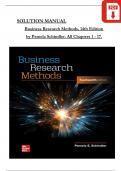Exam (elaborations)
Solution Manual for Business Research Methods, 14th Edition by Pamela Schindler, Verified Chapters 1 to 17, Complete
Pamela Schindler, Business Research Methods, 14th Edition SOLUTION MANUAL, Complete Chapters 1 - 17, Verified Latest Version Solution Manual for Business Research Methods, 14th Edition by Pamela Schindler, Verified Chapters 1 to 17, Complete Newest Version Solution Manual for Business Research Meth...
[Show more]



